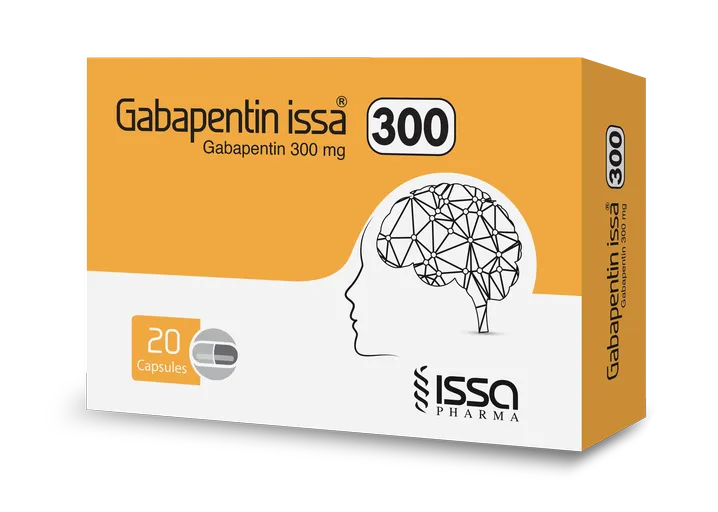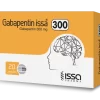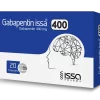COMPOSITION AND EXCIPIENTS
Active ingredient:
Each capsule of Gabapentin issa 100 contains Gabapentin 100 mg.
Each capsule of Gabapentin issa 300 contains Gabapentin 300 mg.
Each capsule of Gabapentin issa 400 contains Gabapentin 400 mg.
Excipients:
Pregelatinised starch, Starch, Talc, Colloidal Anhydrous Silica.
PHARMACOKINETICS
All pharmacological actions following gabapentin administration are due to the activity of the parent compound, gabapentin is not appreciably metabolized in humans.
Oral Bioavailability:
Gabapentin bioavailability is not dose proportional; i.e., as dose is increased, bioavailability decreases. Food has only a slight effect on the rate and extent of absorption of gabapentin (14% increase in AUC and Cmax).
Distribution:
Less than 3% of gabapentin circulates bound to plasma protein.
Elimination:
Gabapentin is eliminated from the systemic circulation by renal excretion as unchanged drug. Gabapentin is not appreciably metabolized in humans.
Gabapentin elimination half-life is 5 to 7 hours and is unaltered by dose or following multiple dosing. Gabapentin elimination rate constant, plasma clearance, and renal clearance are directly proportional to creatinine clearance. In elderly patients, and in patients with impaired renal function, gabapentin plasma clearance is reduced. Gabapentin can be removed from plasma by hemodialysis.
INDICATIONS
Gabapentin is indicated for:
Management of postherpetic neuralgia in adults.-
=Adjunctive therapy in the treatment of partial onset seizures, with and without secondary generalization, in adults and pediatric patients 3 years and older with epilepsy.
CONTRAINDICATION
Gabapentin is contraindicated in patients who have demonstrated hypersensitivity to the drug or its ingredients.
ADVERS REACTIONS
The most common side effects of gabapentin include:
lack of coordination, viral infection, dizziness, feeling drowsy, nausea and vomiting, difficulty with speaking, tremor,
swelling, usually of legs and feet, feeling tired, fever, jerky movements, difficulty with coordination, double vision, unusual eye movement.
These are not all the possible side effects of gabapentin. For more information, ask your healthcare provider or pharmacist.
DRUG INTERACTIONS
Other Antiepileptic Drugs:
Gabapentin is not appreciably metabolized nor does it interfere with the metabolism of commonly coadministered antiepileptic drugs.
Hydrocodone:
Coadministration of gabapentin with hydrocodone decreases hydrocodone exposure. The potential for alteration in hydrocodone exposure and effect should be considered when gabapentin is started or discontinued in a patient taking hydrocodone.
Morphine:
When gabapentin is administered with morphine, patients should be observed for signs of central nervous system (CNS) depression, such as somnolence, sedation and respiratory depression
Antacid (aluminum hydroxide, magnesium hydroxide):
Antacid containing magnesium and aluminum hydroxides reduced the mean bioavailability of gabapentin (N=16) by about 20%. It is recommended that gabapentin be taken at least 2 hours following Antacid.
WARNINGS AND PRECAUTIONS
Drug interaction with frequent eosinophils and systemic symptoms (DRESS)/ Hypersensitivity in several organs:
Drug Reaction with Eosinophilia and Systemic Symptoms (DRESS), also known as multiorgan hypersensitivity, has occurred with gabapentin. Some of these reactions have been fatal or life threatening. DRESS typically, although not exclusively, presents with fever, rash, and/or lymphadenopathy, in association with other organ system involvement, such as hepatitis, nephritis, hematological abnormalities, myocarditis, or myositis sometimes resembling an acute viral infection. Eosinophilia is often present. This disorder is variable in its expression, and other organ systems not noted here may be involved.
It is important to note that early manifestations of hypersensitivity, such as fever or lymphadenopathy, may be present even though rash is not evident. If such signs or symptoms are present, the patient should be evaluated immediately. Gabapentin should be discontinued if an alternative etiology for the signs or symptoms cannot be established.
Anaphylaxis And Angioedema:
Gabapentin can cause anaphylaxis and angioedema after the first dose or at any time during treatment. Signs and symptoms in reported cases have included difficulty breathing, swelling of the lips, throat, and tongue, and hypotension requiring emergency treatment. Patients should be instructed to discontinue gabapentin and seek immediate medical care should they experience signs or symptoms of anaphylaxis or angioedema.
Suicidal behavior and ideation:
Patients, their caregivers, and families should be informed that AEDs increase the risk of suicidal thoughts and behavior and should be advised of the need to be alert for the emergence or worsening of the signs and symptoms of depression, any unusual changes in mood or behavior, or the emergence of suicidal thoughts, behavior, or thoughts about self-harm. Behaviors of concern should be reported immediately to healthcare providers.
It can cause in children 3 to 12 years of age emotional changes, aggressive behavior, problems with concentration, restlessness, changes in school performance, and hyperactivity.
Driving and using machines:
Because gabapentin causes somnolence and dizziness, patients should be advised not to operate complex machinery until they have gained sufficient experience to gauge whether or not it affects their mental and/or motor performance adversely.
Withdrawal Precipitated Seizure, Status Epilepticus :
Antiepileptic drugs should not be abruptly discontinued because of the possibility of increasing seizure frequency.
Pregnancy:
Pregnancy Category C
There are no adequate and well-controlled studies in pregnant women. In nonclinical studies in mice, rats, and rabbits, gabapentin was developmentally toxic when administered to pregnant animals at doses similar to or lower than those used clinically. Gabapentin should be used during pregnancy only if the potential benefit justifies the potential risk to the fetus.
Nursing Mothers:
Gabapentin is secreted into human milk following oral administration. A nursed infant could be exposed to a maximum dose of approximately 1 mg/kg/day of gabapentin. Because the effect on the nursing infant is unknown, should be used in women who are nursing only if the benefits clearly outweigh the risk.
Pediatric Use:
Safety and effectiveness of gabapentin in the management of postherpetic neuralgia in pediatric patients have not been established.
Effectiveness as adjunctive therapy in the treatment of partial seizures in pediatric patients below the age of 3 years has not been established.
DOSAGE AND ADMINISTRATION
Dosage For Postherpetic Neuralgia:
In adults with postherpetic neuralgia, gabapentin may be initiated on Day 1 as a single 300 mg dose, on Day 2 as 600 mg/day (300 mg two times a day), and on Day 3 as 900 mg/day (300 mg three times a day). The dose can subsequently be titrated up as needed for pain relief to a dose of 1800 mg/day (600 mg three times a day). In clinical studies, efficacy was demonstrated over a range of doses from 1800 mg/day to 3600 mg/day with comparable effects across the dose range; however, in these clinical studies, the additional benefit of using doses greater than 1800 mg/day was not demonstrated.
Dosage For Epilepsy With Partial Onset Seizures:
Patients 12 Years Of Age And Above:
The starting dose is 300 mg three times a day. The recommended maintenance dose of gabapentin is 300 mg to 600 mg three times a day. Dosages up to 2400 mg/day have been well tolerated in long-term clinical studies. Doses of 3600 mg/day have also been administered to a small number of patients for a relatively short duration, and have been well tolerated. Administer gabapentin three times a day using 300 mg or 400 mg capsules. The maximum time between doses should not exceed 12 hours.
Pediatric Patients Age 3 To 11 Years:
The starting dose range is 10 mg/kg/day to 15 mg/kg/day, given in three divided doses, and the recommended maintenance dose reached by upward titration over a period of approximately 3 days. The recommended maintenance dose of gabapentin in patients 3 to 4 years of age is 40 mg/kg/day, given in three divided doses. The recommended maintenance dose of gabapentin in patients 5 to 11 years of age is 25 mg/kg/day to 35 mg/kg/day, given in three divided doses. Gabapentin may be administered as the oral solution, capsule, or tablet, or using combinations of these formulations. Dosages up to 50 mg/kg/day have been well tolerated in a long-term clinical study. The maximum time interval between doses should not exceed 12 hours.
Dosage Adjustment In Patients With Renal Impairment:
Dosage adjustment in patients 12 years of age and older with renal impairment or undergoing hemodialysis is recommended, as follows:
TABLE 1: Dosage Based on Renal Function
Renal Function Creatinine Clearance | Total Daily Dose Range | Dose Regimen | ||||
≥ 60 | 900 to 3600 | 300 | 400 | 600 | 800 | 1200 |
>30 to 59 | 400 to 1400 | 200 | 300 | 400 | 500 | 700 |
>15 to 29 | 200 to 700 | 200 | 300 | 400 | 500 | 700 |
15* | 100 to 300 | 100 | 125 | 150 | 200 | 300 |
Post-Hemodialysis Supplemental Dose (mg) ٭ | ||||||
Hemodialysis | 125٭ | 150 ٭ | 200 ٭ | 250 ٭ | 350 ٭ | |
*For patients with creatinine clearance <15 mL/min, reduce daily dose in proportion to creatinine clearance (e.g., patients with a creatinine clearance of 7.5 mL/min should receive one-half the daily dose that patients with a creatinine clearance of 15 mL/min.
٭ Patients on hemodialysis should receive maintenance doses based on estimates of creatinine clearance as indicated in the upper portion of the table and a supplemental post-hemodialysis dose administered after each 4 hours of hemodialysis as indicated in the lower portion of the table.
Dosage In Elderly:
Because elderly patients are more likely to have decreased renal function, care should be taken in dose selection, and dose should be adjusted based on creatinine clearance values in these patients.
Administration Information:
Administer orally with or without food.
OVERDOSE Gabapentin capsules should be swallowed whole with water.
If the gabapentin dose is reduced, discontinued, or substituted with an alternative medication, this should be done gradually over a minimum of 1 week (a longer period may be needed at the discretion of the prescriber).
OVERDOSE
A lethal dose of gabapentin was not identified in mice and rats receiving single oral doses as high as 8000 mg/kg. Signs of acute toxicity in animals included ataxia, labored breathing, ptosis, sedation, hypoactivity, or excitation.
Acute oral overdoses of gabapentin up to 49 grams have been reported. In these cases, double vision, slurred speech, drowsiness, lethargy, and diarrhea were observed. All patients recovered with supportive care. Coma, resolving with dialysis, has been reported in patients with chronic renal failure who were treated with gabapentin.
Gabapentin can be removed by hemodialysis. Although hemodialysis has not been performed in the few overdose cases reported, it may be indicated by the patient’s clinical state or in patients with significant renal impairment.
STORAGE CONDITIONS
Store at temperature below 25°, away from light and moisture.
PACKAGING
Gabapentin issa is supplied as blister strips (Aluminum – Clear P.V.D.C), each strip contains 10 capsules and each pack contains 1 or 3 strips with enclosed leaflet ( 10 or 30 capsules per pack).





